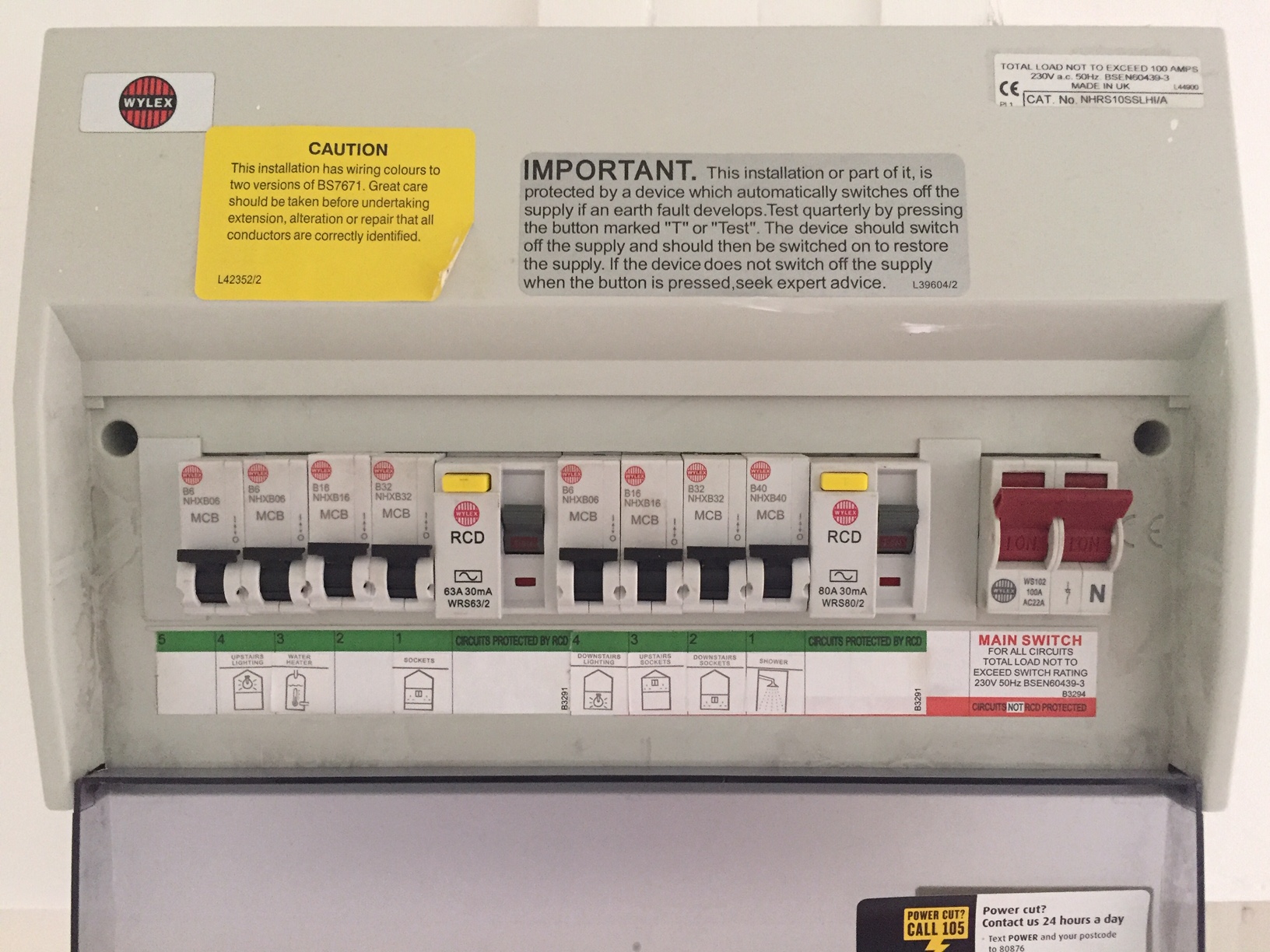Consumer unit
This term 'consumer unit' is now officially defined within the 2018 edition of BS 7671 (IET Wiring Regulations) as:
| A particular type of distribution board comprising a type-tested co-ordinated assembly for the control and distribution of electrical energy, principally in domestic premises, incorporating manual means of double pole isolation on the incoming circuit(s) and an assembly of one or more fuses, circuit breakers, residual current operated devices or signalling and another control devices proven during the type-test of the assembly as suitable for such use. |
To many, the consumer unit is the modern-day equivalent of a ‘fuse box’ or ‘fuse board’ and provides the origin of all outgoing final circuits.
Successive evolutions of BS 7671 over the last few decades have seen the requirements for consumer units grow substantially – not only in what they may house, but also their construction – particularly in recent years with regards to increased fire safety.
The most recent version of BS 7671 in 2018 (the 18th Edition) now imposes much greater emphasis on ensuring that all such equipment that may be housed in such a consumer unit, often to fulfil specific individual purposes, is properly considered with respect to how it performs alongside other equipment in its vicinity. This will include attributes such as thermal performance, magnetic effects, fixing details and terminations, ability to withstand fault levels as well as current carrying capacity.
--ECA
NB Housing statistics and English Housing Survey, glossary, published by the Department for Levelling Up, Housing and Communities in 2019, states: ‘…in older systems, each individual electrical circuit was fed through an individual switch and fuse box. From 1960s through to the 1980s, fuses were collected together into a small number of smaller boxes, normally with a switch on the front which controlled all the circuits leading to the box. These boxes were normally fitted with a cover, the removal of which gave access to the fuses hidden inside. From the early 1980s, the newly named consumer unit (some dwellings have 2) catered for the whole dwelling and was also designed to accommodate modern safety measures namely circuit breakers and residual current devices.’
Related articles on Designing Buildings
- Articles about electricity.
- Circuit breaker.
- Consumer electronics.
- Domestic micro-generation.
- ECA articles.
- Electric motor.
- Electrical appliance.
- Electrical component.
- Electrical consumption.
- Electrical energy.
- Electrical installation.
- Electrical power.
- Electrician.
- Electrical safety.
- Electricity bill.
- Electricity supply.
- Flexible electrical networks for a low carbon future.
- Fuse.
- Glossary of electrical terms.
- Miniature circuit breaker.
- Panelboard.
- Radial circuit.
- Residual current device.
- The Future of Electricity in Domestic Buildings.
Featured articles and news
Delivering for tenants; National Retrofit Hub
New report offers recommendations to strengthen energy efficiency standards to protect private renters.
Government consultations for the summer of 2025
A year of Labour, past and present consultations on the environment, the built environment, training and tax.
CMA competitiveness probe of major housing developers
100 million affordable housing contributions committed with further consultation published.
Homes England supports Greencore Homes
42 new build affordable sustainable homes in Oxfordshire.
Zero carbon social housing: unlocking brownfield potential
Seven ZEDpod strategies for brownfield housing success.
CIOB report; a blueprint for SDGs and the built environment
Pairing the Sustainable Development Goals with projects.
Types, tests, standards and fires relating to external cladding
Brief descriptions with an extensive list of fires for review.
Latest Build UK Building Safety Regime explainer published
Key elements in one short, now updated document.
UKGBC launch the UK Climate Resilience Roadmap
First guidance of its kind on direct climate impacts for the built environment and how it can adapt.
CLC Health, Safety and Wellbeing Strategy 2025
Launched by the Minister for Industry to look at fatalities on site, improving mental health and other issues.
One of the most impressive Victorian architects. Book review.
Common Assessment Standard now with building safety
New CAS update now includes mandatory building safety questions.
RTPI leader to become new CIOB Chief Executive Officer
Dr Victoria Hills MRTPI, FICE to take over after Caroline Gumble’s departure.
Social and affordable housing, a long term plan for delivery
The “Delivering a Decade of Renewal for Social and Affordable Housing” strategy sets out future path.
A change to adoptive architecture
Effects of global weather warming on architectural detailing, material choice and human interaction.
The proposed publicly owned and backed subsidiary of Homes England, to facilitate new homes.
How big is the problem and what can we do to mitigate the effects?
Overheating guidance and tools for building designers
A number of cool guides to help with the heat.
The UK's Modern Industrial Strategy: A 10 year plan
Previous consultation criticism, current key elements and general support with some persisting reservations.
Building Safety Regulator reforms
New roles, new staff and a new fast track service pave the way for a single construction regulator.




























Comments
[edit] To make a comment about this article, click 'Add a comment' above. Separate your comments from any existing comments by inserting a horizontal line.